#cloud access manager sap
Explore tagged Tumblr posts
Text
SAP IAG for Enhanced Access Governance - ToggleNow
Understanding SAP Identity Access Governance (IAG) SAP IAG serves as a comprehensive framework within the SAP ecosystem, designed to manage user access, control risks, and ensure compliance with regulatory standards. Its primary focus lies in governing user access across various SAP applications that are hosted on-premise and cloud along with other non-sap systems such as Azure ID, and platforms.
Access Analysis Service Similar to SAP GRC, SAP IAG also has powerful capabilities to assess and mitigate access risks associated with user permissions. It conducts thorough analysis, identifying potential risks and vulnerabilities within the access structure. A clear definition of risks are displayed for each of the users enabling the Business Owners to take better decisions on managing the risks for each of the user.
Privileged Access Management (PAM) Service PAM Service is similar to GRC Access Control Emergency Access Management aka Firefighter, a specialized solution designed to manage critical access by controlling, monitoring, and securing the SAP systems from unauthorized changes using privileged accounts. It focuses on a more controlled assignment and management of accesses which has business impact. PAM ensure compliance with regulatory standards, thereby fortifying the overall security posture of an enterprise.

Role Designer Service Role Designer service in SAP Identity Access Governance (IAG) is a pivotal tool facilitating the creation and management of user roles within an organization’s access governance framework. It enables administrators to design, customize, and maintain role structures, aligning access with specific job functions or departments. Leveraging Role Designer, businesses can streamline access provisioning by defining business roles, assigning parameters.
Access Request Service The Access Request service feature enables users to request access rights based on predefined roles for various applications integrated to SAP IAG. It streamlines the process, ensuring quick and accurate provisioning while maintaining control. Access Request supports pre-defined workflows and can provision to various on-premise, and cloud applications such as SAP BTP, SAP SAC etc.
Access Certification Periodic access reviews are crucial for compliance. SAP IAG automates access certification processes, allowing designated individuals to review and confirm user access rights periodically. How Access Governance can be enhanced with SAP IAG? Streamlined Access Requests and Approvals
SAP IAG simplifies the access request process by providing a user-friendly interface. Users can easily request specific access rights aligned with their job responsibilities. These requests are then routed through customizable approval workflows, ensuring compliance with defined policies before granting access.
Risk Mitigation through Access Analysis
With its robust risk analysis capabilities, SAP IAG identifies and evaluates potential risks associated with user access. It conducts in-depth assessments, highlighting access combinations that might pose security threats or regulatory non-compliance. This proactive approach enables organizations to mitigate risks effectively. SAP IAG offers refinement options such as Simple Refinement, and Advanced Refinement in addition to the regular Mitigation options.
Further, the SAP IAG Ruleset is delivered with risks related to APO, BASIS, HR, R3, SRM, S4HANA On-premise, S4HANA Cloud, ARIBA, SuccessFactors, Fieldglass, and IBP. For more details on the supported systems, refer to SAP Note – 2782388 – IAG – How to load default standard ruleset?
Automated Access Reviews and Certifications
Manual access reviews are time-consuming and prone to errors. SAP IAG automates these processes, scheduling periodic access reviews and certifications. This automation ensures that user access remains aligned with current job roles and business needs, reducing the risk of unauthorized access.
Role-Based Access Control (RBAC)
SAP IAG facilitates Role-Based Access Control, a method of managing access based on job roles, referred to as Business Roles in IAG. It streamlines access provisioning by assigning roles that are pre-analyzed, and all the relevant mapping is done. This approach simplifies access management while reducing the risk of excessive access rights.
How difference SAP IAG is compared to SAP GRC Access Control? Great Question! Despite sharing similar functionalities, SAP IAG and SAP GRC Access Control possess unique capabilities, advantages, and drawbacks. Comparing them is akin to comparing apples and oranges solely based on their commonality as fruits or similar features. Just like distinct fruits with their individual properties, each of these solutions has its own set of characteristics and benefits.
Read more : https://togglenow.com/blog/sap-iag-for-enhanced-access-governance/
#sap sod analysis#sap user management automation#GRC Access Control#SAP Cloud Identity Services#SAP IAG Implementation#Cloud IAG#SAP Cloud IAG#SAP IAG Access Analysis#SAP IAG Integration with GRC#SAP Cloud IAG Integration#SAP IAG- Analytics Cloud Integration#sap cloud identity management#sap cloud based solutions
0 notes
Text
Best ERP Software: Empowering Businesses Through Digital Transformation
In today’s fast-paced digital economy, businesses are constantly challenged to improve efficiency, reduce costs, and enhance customer satisfaction. Legacy systems and disconnected processes can no longer support these evolving demands. That’s where Enterprise Resource Planning (ERP) software steps in — providing a unified platform to streamline all business operations.
Whether you're a small enterprise or a multinational company, choosing the best ERP software is critical to maintaining a competitive edge.
What’s ERP Software
ERP (Enterprise Resource Planning) software is an integrated suite of applications that helps businesses manage core functions such as:
Accounting & Finance
Inventory & Warehouse
Sales & CRM
Procurement
Manufacturing
HR & Payroll
Project Management
With real-time data and centralized control, ERP enables informed decision-making and business agility.
Why Your Business Needs ERP
Here’s how ERP software transforms your operations:
Eliminates Silos: Connects all departments in one system
Boosts Productivity: Automates manual and repetitive tasks
Enhances Visibility: Real-time dashboards and analytics
Improves Customer Experience: Faster response times and order fulfillment
Ensures Compliance: Built-in features to meet industry standards and tax regulations
Top Features to Look for in the Best ERP Software
To maximize ROI, ensure your ERP includes:
Customizable Modules – Tailor the system to fit your unique business model
Cloud Access – Access your data from anywhere with secure cloud hosting
User-Friendly Interface – Easy to learn and use by non-technical staff
Scalability – Grows with your business
Integration Capability – Seamlessly connects with other platforms like eCommerce, banking, or logistics
Real-Time Reporting – For informed decision-making
Mobile Access – Monitor operations from any device
Best ERP Software Options in the Market
Here are some globally recognized ERP platforms:
1. Odoo ERP
Highly customizable, open-source, and cost-effective for SMEs and large enterprises.
2. SAP Business One
Robust and ideal for large enterprises with complex needs.
3. Microsoft Dynamics 365
Flexible and integrates seamlessly with the Microsoft ecosystem.
4. Oracle NetSuite
Best for fast-growing companies looking for a cloud-based ERP.
Why Odoo ERP is the Best Fit for Most Businesses
Among the top choices, Odoo ERP stands out due to its:
Open-source flexibility
Modular structure
Lower cost of ownership
Customizability for any industry (Retail, Manufacturing, Services, Trading, etc.)
Easy third-party integrations
Fast deployment
Who Should Implement Your ERP?
Implementing ERP is as important as selecting the right software. A poor implementation can lead to cost overruns and process disruptions. That’s why choosing an experienced ERP partner is key.
Why Banibro is the Right ERP Partner for You
Banibro IT Solutions is a trusted Odoo ERP partner with over 10 years of experience in delivering digital transformation for companies across India, UAE, Qatar, and beyond.
Key Benefits of Choosing Banibro:
End-to-end ERP implementation and support
Industry-specific ERP customization
Strong expertise in Odoo and cloud hosting
Affordable and scalable solutions
Fast deployment with ongoing support and training
Served 300+ clients across manufacturing, trading, logistics, services, and retail
Final Thoughts
Investing in the best ERP software is no longer a luxury — it’s a necessity in a digital-first world. ERP not only automates your operations but also provides a foundation for innovation, growth, and competitive advantage.
If you’re ready to upgrade your business systems and want expert guidance on ERP selection and implementation, Banibro is here to help.
Banibro Contact Details
Website: https://banibro.com Phone:+91 93422 58771 Email: [email protected]
Click here to contact Banibro and schedule a free ERP consultation.
1 note
·
View note
Text
Cloud-based ERP and Business- Right Time to Migrate is Now
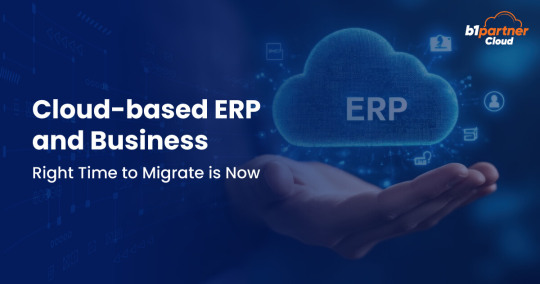
Many businesses rely on SAP Business One (SAP B1) to optimize their workflows and increase operational efficiency. However, small and medium-sized businesses (SMBs) with diverse business models require more advanced solutions to stay competitive in today’s fast-paced environment. Cloud technology can address this need, and the SAP Business One Cloud solution offers numerous benefits, giving businesses an edge over competitors.
In this article, we will explore the importance of cloud-based SAP Business One and key factors to consider before migrating your existing SAP B1 to the cloud. Let's begin by understanding the concept of cloud-based ERP.
Importance of Moving On-Premise SAP B1 to the Cloud
A cloud-powered ERP solution differs from an on-premise one in that it doesn’t require any hardware or software installation. As a managed cloud solution, it provides seamless access from anywhere, anytime, as long as there is an internet connection. SAP Business One Cloud is an example of such a cloud ERP solution.
In today’s environment, where digital transformation is key to success, transitioning to a cloud-based solution is a strategic decision for businesses. Migrating your on-premise SAP B1 to the cloud offers benefits such as scalability, agility, and flexibility, all at a lower cost.
For many SMBs and startups, this cloud-based solution helps reduce costs and enhances productivity through the power of cloud technology. However, it's essential to consider several factors during SAP Business One Cloud migration to fully leverage these benefits. Let’s look at these factors before outlining the step-by-step guide for migrating your SAP B1 system to the cloud.
Key Considerations Before Migrating to SAP Business One Cloud
SAP Business One Cloud can provide significant advantages for forward-looking SMEs. However, migrating your existing SAP B1 to the cloud is a complex process with many factors to consider. When deciding to migrate to SAP Business One Cloud, keep the following factors in mind:
1. Cost of Ownership
This is one of the most crucial factors, whether you're deploying SAP B1 to the cloud or migrating your current ERP. Cloud-based SAP Business One requires monthly subscription fees for access to licenses. However, this cost is much lower than that of on-premise solutions, which demand expensive in-house infrastructure and continuous maintenance.
2. Implementation Time
Implementing an on-premise SAP Business One ERP can take anywhere from 3 to 6 months. Many small and mid-sized businesses find this process cumbersome and time-consuming. Cloud migration is generally quicker and more efficient. A trusted managed cloud services provider can handle the migration process with minimal disruption and in less time.
3. Collaboration and Accessibility
With remote or hybrid working becoming the norm post-pandemic, it’s essential to ensure the cloud-based ERP is easily accessible for remote teams. The SAP B1 Cloud should be available to users anywhere, via the internet. Additionally, it should support seamless collaboration between different teams, no matter their location.
4. Reliability of Provider
The reliability of your cloud service provider is a critical factor. Many cloud providers offer cloud migration services, but it’s vital to choose a trusted and reputable one. Understand the terms of maintenance, upgrades, and technical support to ensure minimal disruptions during your SAP B1 migration to the cloud.
Step-by-Step Guide to Migrate Your Existing SAP B1 to the Cloud
SAP Business One Cloud is a popular solution for small and mid-sized businesses. Regardless of the industry, businesses can benefit from a cloud-based ERP solution by migrating their on-premise SAP B1. Here’s a step-by-step guide to completing the migration process effectively:
Step 1: Assess Existing Environment
Before initiating the migration, it’s crucial to evaluate your current setup and business needs. Examine dependencies, customizations, goals, and integrations with the help of a cloud service provider. This will help you identify potential challenges and ensure a smooth transition from on-premise to the cloud.
Step 2: Choose the Right Plan
Managed cloud providers offer various plans to meet different business needs. You’ll need to select a plan that aligns with your company’s size, goals, and performance requirements. Consider factors such as data storage, scalability, and processing power when choosing a package.
Step 3: Backup and Data Storage
During the migration process, protecting corporate data is vital. Make sure to back up your on-premise SAP B1 data to prevent any data loss or corruption during the migration. Using advanced migration tools can help ensure a seamless transfer and minimize downtime while maintaining data integrity.
Step 4: Application and Database Migration
The next step is migrating your SAP Business One application and databases to the cloud server. A technical team from your cloud service provider can assist in ensuring a secure and efficient migration. Once the transfer is complete, validate the functionality of your SAP B1 application in the new cloud environment.
Step 5: Integration and Performance Testing
Thoroughly test all integrations with other business applications and processes to ensure seamless connectivity in the cloud-driven environment. Extensive testing will help identify and resolve compatibility issues, ensuring uninterrupted workflows and synchronized data.
Step 6: User Training and Adoption
Prepare your team for the transition by providing comprehensive training on the new cloud-based environment. This will help users familiarize themselves with the enhanced features, accessibility, and collaboration tools available in the cloud.
Step 7: Go Live and Monitoring
Coordinate with your cloud provider’s support team to finalize the process and go live. Implement robust monitoring tools to track system performance, identify issues, and ensure the continued optimization of your SAP Business One application in the cloud.
By following these steps, you can ensure that your migration process is successful, allowing your business to unlock the full potential of a cloud-based SAP B1 solution.
Conclusion
Migrating your existing SAP Business One on-premise solution to the cloud can be a complex process, but with the right strategy and approach, it can bring substantial benefits to your business. By following the step-by-step guide and considering key factors during the migration, you can ensure a smooth transition and a successful cloud implementation. The right cloud partner will help you minimize downtime and safeguard your data, unlocking new possibilities with SAP B1 Cloud.
B1 Partner Cloud is a trusted SAP solutions provider, offering a full range of services from implementation to maintenance, upgrades, and cloud migration. Contact us today to learn more about how we can assist with your SAP Business One cloud migration.
Source - https://www.b1partner.cloud/cloud-based-erp-and-business-right-time-to-migrate-is-now/
2 notes
·
View notes
Text
Unlocking Business Potential with SAP Machine Learning Solutions

In the ever-evolving world of business technology, companies must embrace innovative solutions to stay ahead of the competition. SAP, a global leader in enterprise software, has developed a suite of powerful tools that integrate machine learning, analytics, and artificial intelligence to revolutionize business operations. For organizations looking to optimize their business processes and unlock insights, CBS Consulting leverages the best of these SAP solutions, offering expertise in SAP Machine Learning, SAP Analytics Cloud (SAC), SAP S/4HANA Utilities (IS-U), SAP Generative AI, and SAP Signavio.
SAP Machine Learning: Empowering Businesses with Intelligence
SAP Machine Learning solutions are designed to bring artificial intelligence capabilities into the heart of business operations. Using historical data and advanced algorithms, businesses can predict trends, automate processes, and improve decision-making. With SAP's Machine Learning models, organizations can enhance customer experience, streamline supply chains, and optimize financial forecasting. CBS Consulting helps organizations integrate SAP Machine Learning into their workflows, enabling them to automate routine tasks and gain deeper insights into their operations.
SAP Analytics Cloud (SAC): Unlocking Business Insights
SAP Analytics Cloud (SAC) is a cloud-based solution that combines business intelligence, planning, and predictive analytics into one unified platform. SAC allows organizations to access real-time data, visualize trends, and create detailed reports that aid decision-making. With its powerful AI capabilities, SAC enables users to forecast future trends and identify growth opportunities. CBS Consulting assists companies in harnessing the full potential of SAC, providing tailored solutions that allow businesses to extract meaningful insights from their data and drive strategic actions.
SAP S/4HANA Utilities (IS-U): Modernizing Utility Management
For utility companies, SAP S/4HANA Utilities (IS-U) is a game-changer. This solution provides a comprehensive platform for managing customer services, billing, and energy data. Using SAP S/4HANA IS-U, utilities can streamline their processes, reduce operational costs, and improve customer satisfaction. CBS Consulting specializes in implementing SAP S/4HANA IS-U for utility companies, offering the expertise needed to enhance billing accuracy, streamline workflows, and optimize customer relationships in a competitive market.
SAP Generative AI: Shaping the Future of Innovation
SAP Generative AI is transforming how businesses approach problem-solving and innovation. This cutting-edge AI technology can generate new ideas, design prototypes, and even simulate product solutions based on vast datasets. By leveraging SAP Generative AI, companies can drive innovation and create unique products faster. CBS Consulting works with organizations to integrate Generative AI into their workflows, ensuring they can unlock new avenues for creativity and business growth.
SAP Signavio: Optimizing Business Processes
SAP Signavio is an intelligent business process management tool that allows organizations to visualize, analyze, and optimize their workflows. With SAP Signavio, companies can better understand their processes, identify inefficiencies, and implement changes that improve productivity. CBS Consulting helps businesses optimize their processes using SAP Signavio, ensuring they achieve operational excellence and meet customer demands with greater agility.
Conclusion
By integrating SAP's cutting-edge solutions like SAP Machine Learning, SAP Analytics Cloud, SAP S/4HANA Utilities, SAP Generative AI, and SAP Signavio, CBS Consulting helps businesses unlock their full potential. CBS Consulting empowers organizations with tailored expertise and proven strategies to automate processes, enhance decision-making, and drive growth in a rapidly changing business environment.
1 note
·
View note
Text
Manufacturing ERP: The Top 10 ERP Systems for 2024
Introduction:
In the dynamic landscape of the manufacturing industry, the right technology can make all the difference in streamlining processes and enhancing overall efficiency. Manufacturing Enterprise Resource Planning (ERP) systems have become indispensable tools for businesses seeking to integrate various facets of their operations seamlessly. As we step into 2024, the demand for robust ERP solutions continues to grow. In this blog, we will explore the top 10 Manufacturing ERP systems that are poised to make a significant impact on the industry this year.
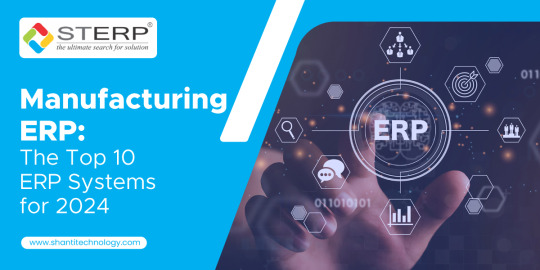
1. SAP S/4HANA: Pioneering Manufacturing Resource Planning System
One of the most trusted names in ERP, SAP S/4HANA stands out as a comprehensive Manufacturing Resource Planning System. Its real-time analytics, integrated modules, and intelligent automation make it an ideal choice for businesses aiming to optimize their manufacturing processes.
2. Oracle ERP Cloud: Empowering Manufacturing Enterprise Resource Planning
Oracle ERP Cloud offers a scalable and flexible solution for manufacturing enterprises. With its robust features, it caters to the diverse needs of businesses, ensuring a seamless integration of manufacturing operations. Its cloud-based architecture provides the agility required for modern manufacturing environments.
3. Microsoft Dynamics 365: A Versatile ERP Solution
Microsoft Dynamics 365 is gaining prominence as a Manufacturing Enterprise Resource Planning software that offers versatility and integration capabilities. Its user-friendly interface and interoperability with other Microsoft products make it an attractive choice for businesses, especially small enterprises.
4. Infor CloudSuite Industrial: Tailored Manufacturing ERP
Infor CloudSuite Industrial is designed with the unique needs of manufacturers in mind. It provides specialized functionalities, including supply chain management and shop floor control, making it a standout choice among ERP solution providers.
5. NetSuite ERP: Unifying Manufacturing Operations
NetSuite ERP is recognized for its ability to unify diverse manufacturing operations into a single, cohesive system. Its cloud-based platform allows for real-time collaboration and data accessibility, making it an efficient Manufacturing Enterprise Resource Planning Software.
6. Epicor ERP: Driving Growth for Small Businesses
Epicor ERP is particularly well-suited for small businesses in the manufacturing sector. With its focus on driving growth and improving efficiency, Epicor ERP offers a cost-effective solution without compromising on essential features.
7. IFS Applications: Comprehensive ERP Solution
IFS Applications is a comprehensive ERP solution that covers a wide range of manufacturing processes. Its modular structure allows businesses to tailor the system according to their specific requirements, making it a preferred choice for Manufacturing Enterprise Resource Planning.
8. IQMS Manufacturing ERP: Enhancing Shop Floor Control
IQMS Manufacturing ERP is distinguished by its emphasis on shop floor control and real-time monitoring. It empowers manufacturers with tools to optimize production processes and make informed decisions, positioning it as a top choice among ERP solution providers.
9. Acumatica Cloud ERP: Scalability for Growing Businesses
Acumatica Cloud ERP stands out for its scalability, making it an ideal choice for growing manufacturing businesses. With a flexible platform and advanced features, Acumatica supports businesses in adapting to changing demands and expanding their operations seamlessly.
10. SYSPRO ERP: Tailored for Manufacturing Success
SYSPRO ERP is tailored to meet the specific needs of manufacturing industries. Its focus on delivering a user-friendly experience and addressing industry challenges positions it as a reliable choice for Manufacturing Enterprise Resource Planning.
Conclusion:
As manufacturing industries evolve, the importance of robust ERP systems cannot be overstated. The top 10 ERP systems highlighted in this blog represent the cutting edge of technology, offering solutions that cater to the unique demands of the manufacturing sector. Whether it's SAP S/4HANA's real-time analytics, Oracle ERP Cloud's scalability, or Acumatica Cloud ERP's flexibility, each system brings its own strengths to the table.
For businesses in Madhya Pradesh seeking Manufacturing Software for Small Business, these ERP solutions provide a pathway to enhanced productivity and streamlined operations. Choosing the right Manufacturing ERP system is a critical decision that can impact a company's growth and competitiveness. Evaluate the features, scalability, and industry focus of each system to find the perfect fit for your manufacturing enterprise. Embrace the power of ERP in 2024 and position your business for success in the ever-evolving landscape of manufacturing technology.
#Manufacturing Software for Small Business#Manufacturing Enterprise Resource Planning Software#ERP Solution Providers in Madhya Pradesh#Manufacturing Enterprise Resource Planning#Manufacturing Resource Planning System#ERP Software#Chain Cycle Management#Business#Engineering#Manufacturing#India#Madhya Pradesh#Go-To-Market#GTM#ERP
7 notes
·
View notes
Text
Top 10 Predictive Analytics Tools to Strive in 2024
Predictive analytics has become a crucial tool for businesses, thanks to its ability to forecast key metrics like customer retention, ROI growth, and sales performance. The adoption of predictive analytics tools is growing rapidly as businesses recognize their value in driving strategic decisions. According to Statista, the global market for predictive analytics tools is projected to reach $41.52 billion by 2028, highlighting its increasing importance.
What Are Predictive Analytics Tools?
Predictive analytics tools are essential for managing supply chains, understanding consumer behavior, and optimizing business operations. They help organizations assess their current position and make informed decisions for future growth. Tools like Tableau, KNIME, and Databricks offer businesses a competitive advantage by transforming raw data into actionable insights. By identifying patterns within historical data, these tools enable companies to forecast trends and implement effective growth strategies. For example, many retail companies use predictive analytics to improve inventory management and enhance customer experiences.
Top 10 Predictive Analytics Tools
SAP: Known for its capabilities in supply chain, logistics, and inventory management, SAP offers an intuitive interface for creating interactive visuals and dashboards.
Alteryx: This platform excels in building data models and offers a low-code environment, making it accessible to users with limited coding experience.
Tableau: Tableau is favored for its data processing speed and user-friendly interface, which allows for the creation of easy-to-understand visuals.
Amazon QuickSight: A cloud-based service, QuickSight offers a low-code environment for automating tasks and creating interactive dashboards.
Altair AI Studio: Altair provides robust data mining and predictive modeling capabilities, making it a versatile tool for business intelligence.
IBM SPSS: Widely used in academia and market research, SPSS offers a range of tools for statistical analysis with a user-friendly interface.
KNIME: This open-source tool is ideal for data mining and processing tasks, and it supports machine learning and statistical analysis.
Microsoft Azure: Azure offers a comprehensive cloud computing platform with robust security features and seamless integration with Microsoft products.
Databricks: Built on Apache Spark, Databricks provides a collaborative workspace for data processing and machine learning tasks.
Oracle Data Science: This cloud-based platform supports a wide range of programming languages and frameworks, offering a collaborative environment for data scientists.
Conclusion
As businesses continue to embrace digital transformation, predictive analytics tools are becoming increasingly vital. Companies looking to stay competitive should carefully select the right tools to harness the full potential of predictive analytics in today’s business la
#databricks#oracle data science#sap#alteryx#microsoft#microsoft azure#knime#ibm spss#altair studio#amazon quick sight
1 note
·
View note
Text
SAP Basis
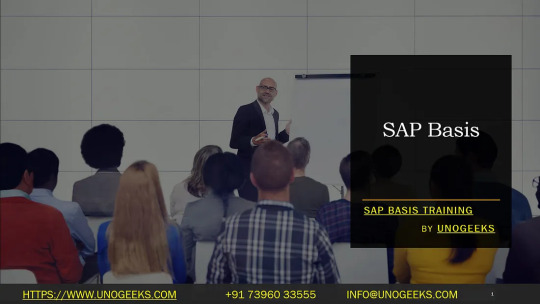
SAP Basis: The Backbone of Your SAP Landscape
SAP applications form the core of many modern enterprises. Financial data, customer interactions, supply chain logistics, and many other critical business operations rely on SAP’s robust solutions. But what powers these solutions? That’s where SAP Basis comes in.
What is SAP Basis?
In simple terms, SAP Basis is the technological foundation upon which SAP applications are built and run. It’s like the operating system specifically for your SAP world. Basis provides a set of middleware components and administration tools that ensure your SAP applications function smoothly and reliably.
Key Responsibilities of an SAP Basis Administrator
SAP Basis administrators are the unsung heroes of the SAP world, responsible for a wide range of tasks:
Installation and Configuration: Basis admins handle the initial installation and setup of SAP systems, ensuring they’re configured correctly for your business needs.
System Administration: They perform ongoing tasks like monitoring system health, applying patches and upgrades, and managing system resources.
Database Management: This includes database installation, configuration, backup and restore processes, and overall database health.
Performance Tuning: Basis admins identify bottlenecks, optimize settings, and ensure applications run at their peak.
User Management: Creating and managing user accounts, assigning roles and authorizations for secure access control.
Troubleshooting: When problems arise, these experts step up to diagnose and resolve issues promptly, minimizing downtime for the business.
Transport Management: They oversee the movement of code changes and configuration updates between different SAP environments (e.g., development, testing, production).
Components of SAP Basis
Some core components that make up SAP Basis include:
SAP NetWeaver: The core technology platform that provides the foundation for different SAP products.
ABAP Workbench: The development environment for creating custom ABAP code (SAP’s primary programming language).
SAP GUI: The graphical user interface used to interact with SAP systems.
Transport Management System: Tools for managing and tracking changes across SAP environments.
Solution Manager: A centralized platform for system monitoring, diagnostics, and support tools.
Why is SAP Basis Important?
Reliability and Stability: A well-managed SAP Basis system means your critical business applications will run smoothly, minimizing disruptions and downtime.
Performance: Basis expertise ensures that your SAP applications are optimized to deliver their best, promoting efficient business operations.
Security: Basis includes a suite of tools to manage user access, protect sensitive data, and ensure compliance with security standards.
Agility: A flexible Basis layer gives your business the ability to adapt to changing needs by scaling SAP deployments or introducing new components.
Becoming an SAP Basis Administrator
A career in SAP Basis is both challenging and rewarding. If you have a knack for technical troubleshooting, problem-solving, and enjoy working with complex systems, here’s how to get started:
Get a Technical Foundation: A background in computer science, database administration, or system administration is a strong starting point.
Gain SAP Expertise: Take SAP Basis training courses and explore online resources and tutorials.
Certifications: Consider getting SAP-certified in Basis administration to validate your skills.
Hands-on Experience: Look for internship or entry-level positions that allow you to work on real SAP systems.
The Future of SAP Basis
As SAP continues to evolve into a cloud-centric platform, Basis will adapt too. Knowledge of cloud technologies, containerization, and automation will become increasingly valuable for Basis administrators.
youtube
You can find more information about SAP BASIS in this SAP BASIS Link
Conclusion:
Unogeeks is the №1 IT Training Institute for SAP BASIS Training. Anyone Disagree? Please drop in a comment
You can check out our other latest blogs on SAP BASIS here — SAP BASIS Blogs
You can check out our Best In Class SAP BASIS Details here — SAP BASIS Training
Follow & Connect with us:
— — — — — — — — — — — -
For Training inquiries:
Call/Whatsapp: +91 73960 33555
Mail us at: [email protected]
Our Website ➜ https://unogeeks.com
Follow us:
Instagram: https://www.instagram.com/unogeeks
Facebook: https://www.facebook.com/UnogeeksSoftwareTrainingInstitute
Twitter: https://twitter.com/unogeek
2 notes
·
View notes
Text
SUCCESSFACTORS HCM

Transforming HR with SAP SuccessFactors HCM
In the fast-paced, ever-changing world of human resources, organizations need powerful tools to streamline processes, elevate the employee experience, and make data-driven decisions. Enter SAP SuccessFactors HCM (Human Capital Management), a leading cloud-based HR solution designed to do just that.
What is SuccessFactors HCM?
SAP SuccessFactors HCM is a comprehensive suite of HR modules that provides businesses with a centralized platform to manage the entire employee lifecycle regardless of size or industry. It covers the full range of HR functions, including:
Core HR & Payroll manages essential employee data, automates payroll, and precisely handles time and attendance.
Talent Management: Streamlines recruiting, onboarding, performance and goal management, learning, compensation, and succession planning.
Employee Experience Management: Enhances employee engagement through surveys, continuous feedback, and action planning.
HR Analytics and Workforce Planning: Delivers powerful insights, enables scenario modeling, and supports strategic people-related decisions.
Why Choose SuccessFactors HCM?
Here are some compelling advantages of using SuccessFactors HCM:
Cloud-Based Flexibility: SuccessFactors is a SaaS (Software-as-a-Service) solution. This means no hefty hardware investments, automatic updates, high accessibility, and the freedom to scale as needed.
Global Reach: Supports multinational operations with multiple languages and currencies and ensures compliance with local regulations.
Seamless Integration: Connects easily with other SAP solutions and third-party systems for a unified business environment.
Employee-Centric Design: Delivers personalized experiences and empowers employees with self-service tools.
Powerful Analytics: Helps HR leaders gain a real-time understanding of their workforce and make insights-based decisions.
Key Use Cases
SuccessFactors HCM can be transformative across various aspects of HR operations:
Streamlining Recruitment: Speed up finding and hiring top talent, ensuring a smooth candidate experience.
Boosting Employee Development: Personalize learning plans, track progress and promote growth within the organization.
Rewarding Performance: Accurately link performance assessments with compensation, ensuring fairness and motivation.
Insightful Planning: Make accurate workforce forecasts, conduct “what-if” scenario analysis, and optimize resource allocation.
Enhancing Engagement: Gather actionable feedback and insights into the overall employee experience.
Getting Started with SuccessFactors HCM
If you’re considering implementing SuccessFactors HCM, remember:
Thorough Assessment: Define your HR needs and how they align with organizational goals.
Specialized Partner: Work with an experienced SAP SuccessFactors implementation partner to ensure a smooth rollout
Change Management: Train your employees and the HR team on the new system. Focus on the benefits and support adoption.
Conclusion
SAP SuccessFactors HCM has the potential to redefine the way businesses manage their most valuable asset—their people. By embracing this platform, organizations can enhance efficiency, nurture talent, gain deeper insights, and build a more engaged workforce.
youtube
You can find more information about SAP HR in this SAP HR Link
Conclusion:
Unogeeks is the No.1 IT Training Institute for SAP HR Training. Anyone Disagree? Please drop in a comment
You can check out our other latest blogs on SAP HR here – SAP HR Blogs
You can check out our Best In Class SAP HR Details here – SAP HR Training
———————————-
For Training inquiries:
Call/Whatsapp: +91 73960 33555
Mail us at: [email protected]
Our Website ➜ https://unogeeks.com
Follow us:
Instagram: https://www.instagram.com/unogeeks
Facebook: https://www.facebook.com/UnogeeksSoftwareTrainingInstitute
Twitter: https://twitter.com/unogeeks
2 notes
·
View notes
Text
SAP HCM
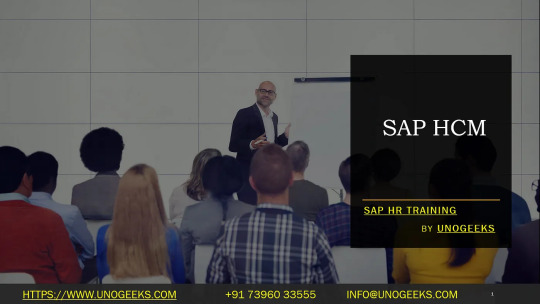
Title: The Power of SAP HCM: Transforming Your HR Operations
Introduction
A robust Human Capital Management (HCM) system is crucial in today’s rapidly evolving business landscape. This is where SAP HCM enters the picture. SAP HCM is a comprehensive suite designed to streamline and optimize all core HR processes, delivering efficiency across your entire organization. Let’s explore what makes SAP HCM so powerful.
What is SAP HCM?
SAP HCM, previously known as SAP HR, sits at the heart of SAP’s newer Human Experience Management (HXM) suite, SAP SuccessFactors. It’s a cloud-based solution offering a range of modules to manage the entire employee lifecycle, including:
Recruitment and Onboarding: Attract, source, hire, and seamlessly onboard the best talent.
Talent Management: Develop employees with performance management, goal setting, succession planning, and training.
Core HR (Personnel Administration): Manage essential employee data, payroll, time, and attendance.
Workforce Analytics and Reporting: Get real-time data insights to support strategic decision-making.
Why Choose SAP HCM?
Improved Employee Experience (EX): SAP HCM puts the employee at the center with intuitive self-service portals, fostering engagement and driving satisfaction.
Boost HR Efficiency: Automate manual HR tasks, saving time and resources while reducing errors.
Streamlined Global Operations: Manage HR processes consistently and competently across countries and regions.
Data-Driven Empowerment: Robust analytics tools enable strategic workforce planning and evidence-based decision-making.
Scalability and Adaptability: SAP HCM is flexible and grows with your business, adjusting to changing HR needs.
Key SAP HCM Modules
While it’s impossible to cover every module or feature, here’s a glimpse into some of the most critical SAP HCM solutions:
Organizational Management: Build your organization’s hierarchical structure, reporting lines, and job descriptions.
Personnel Administration: Centrally manage employee records, contact information, and crucial HR data.
Time Management: Track work schedules absences, calculate leave entitlements, and streamline time-administration processes.
Payroll: Accurately process payroll, meet local tax regulations, and handle benefits complexities.
The Future with SAP SuccessFactors
SAP HCM is continually evolving, and with the introduction of the broader SAP SuccessFactors suite, HR departments now have access to even more advanced tools and features. This includes solutions for continuous performance management, social collaboration, engaging learning experiences, and an emphasis on the holistic employee journey, transforming HCM into HXM (Human Experience Management).
Getting Started with SAP HCM
If you’re looking to unlock efficiency, improve employee satisfaction, and gain valuable HR insights, exploring SAP HCM is a worthwhile venture. Careful planning and teaming up with an experienced SAP implementation partner will ensure your SAP HCM journey is successful. https://youtu.be/61LqSu0GI-Y
You can find more information about SAP HR in this SAP HR Link
Conclusion:
Unogeeks is the №1 IT Training Institute for SAP HR Training. Anyone Disagree? Please drop in a comment
You can check out our other latest blogs on SAP HR here — SAP HR Blogs
You can check out our Best In Class SAP HR Details here — SAP HR Training
Follow & Connect with us:
— — — — — — — — — — — -
For Training inquiries:
Call/Whatsapp: +91 73960 33555
Mail us at: [email protected]
Our Website ➜ https://unogeeks.com
Follow us:
Instagram: https://www.instagram.com/unogeeks
Facebook: https://www.facebook.com/UnogeeksSoftwareTrainingInstitute
Twitter: https://twitter.com/unogeeks
2 notes
·
View notes
Text
Exploring the Significance of ERP Software: How It Works, Why It's Vital for Companies, and the Benefits for Your Business
Enterprise Resource Planning (ERP) software stands as the backbone of modern businesses, planning a masterpiece of operations seamlessly. This comprehensive suite of integrated applications manages core business processes, including finance, HR, inventory, supply chain, and more. Its significance lies in its ability to streamline operations, enhance efficiency, and foster data-driven decision-making.
Cloud-based ERP solutions offer a versatile edge over traditional on-premises systems. They facilitate real-time data accessibility, scalability, and cost-effectiveness. Conversely, on-premises ERP software provides robust security and customization options, ideal for businesses with specific compliance needs or intricate operational structures.
Adopting the best ERP Software Consulting Solutions is a strategic move for companies, as it centralizes disparate processes into a unified platform, eradicates data silos, and enhances collaboration, thereby boosting productivity and offering a comprehensive view of the business for smarter, data-backed decisions."
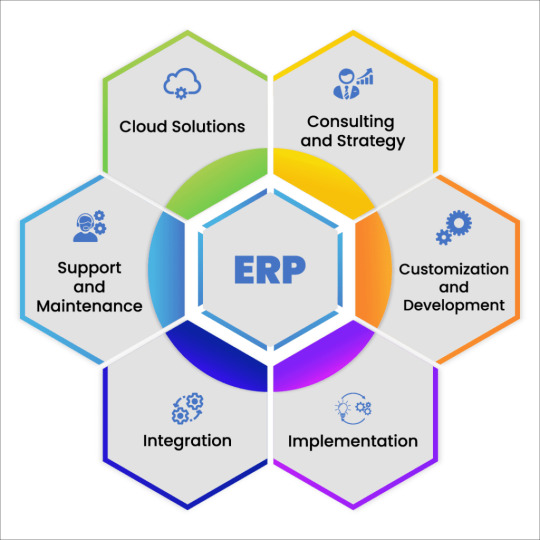
The benefits of ERP software for your business are multifaceted. It optimizes resource utilization, streamlines workflows, minimizes errors, and accelerates reporting cycles. This ultimately results in improved customer satisfaction, reduced operational costs, and better agility in responding to market changes.
When seeking the best ERP software development services, solutions, implementation, or consulting, businesses must prioritize expertise, reliability, and compatibility. The best ERP software development services and solutions cater to unique business needs, offering tailor-made solutions for seamless integration and functionality.
Choosing the best ERP software implementation services or solutions involves a thorough evaluation of the provider's track record, customer reviews, and adaptability to your company's requirements. Expert ERP software consulting services navigate businesses through the maze of choices, ensuring optimal software selection, implementation, and long-term success.
In conclusion, the strategic implementation of ERP software can revolutionize business operations, driving efficiency, innovation, and competitiveness. Selecting the best ERP software development, implementation, and consulting services is pivotal for maximizing the benefits and leveraging the full potential of this transformative technology.
ERP Offerings & Practice's
SAP/S4 HANA ERP Software Solutions
Ellucian Banner ERP Software Solutions
Peoplesoft ERP Software services
Oracle Cloud ERP Software services
UKG ERP Software services
Salesforce ERP Software services
3 notes
·
View notes
Text
What is NetSuite?
NetSuite is a company management system that comes with several modules to assist organizations in managing their finances and operations more effectively and automating more business processes. The enhancements that follow assist businesses in improving customer experiences and increasing worker productivity.
NetSuite's system is offered by netsuite implementation partners, in addition, it is primarily focused on accounting and financial reporting, but it also offers powerful features for inventory management, order management, CRM, analytics, planning and budgeting, professional services automation (PSA), HR, and commerce. Critical business data from each of these business functions is centrally located by NetSuite, which then uses dashboards and user-friendly reporting capabilities to provide the necessary insights.
What is SAP?
Each of SAP's three systems for small and midmarket businesses has gained popularity with organizations of a specific size or in specific verticals. While Business ByDesign is a cloud-only SaaS offering, SAP S/4HANA and Business One can be implemented both on-premises and in the cloud. All three ERP systems cover inventory management, manufacturing, professional services, and human resources to differing degrees, and they all include accounting and finance tools.
For additional capabilities like analytics, human capital management (HCM), CRM, procurement, expense management, or e-commerce, customers can connect these ERP platforms to other SAP solutions. However, these are not comparable to NetSuite modules because many of them are built on different codebases and necessitate frequent intricate integrations. However, sap partners in saudi arabia may offer solutions that aren’t customized for all industries, but when you work with us, we can specifically design your SAP implementation to meet your company's needs.
Read more about sap business one implementation methodology.
SAP vs NetSuite:
Deployment:
The degree of cloud adoption is the primary deployment difference between SAP and NetSuite. Further, netsuite implementation partners provide you with a NetSuite system that is primarily cloud-based, highlighting the scalability and accessibility benefits associated with cloud deployment, whereas SAP offers both on-premises and cloud-based alternatives, giving flexibility to enterprises with various preferences and requirements.
For that, deployment preferences play a major role in the decision between SAP and NetSuite. SAP provides a wider range of alternatives, while netsuite implementation partners focus exclusively on cloud-based deployment, which makes SAP is better choice for you.
Integration:
One of SAP's most well-known features is its ability to easily connect with a wide range of databases and systems, both inside the organization and with external partners. Its strong integration features enable businesses to connect various apps and data sources for a unified picture of their operations. However, netsuite implementation partners provide a cloud-based solution, that offers native integration within its suite of applications, resulting in a single platform for managing business operations. Even though SAP allows for connections with external systems, its integration capabilities are typically broader and more flexible in complex integration scenarios.
Customization:
SAP and netsuite implementation partners approach customization in differing ways. SAP offers a very adaptable system with a multitude of solutions that may be customized to meet specific company requirements in terms of processes, workflows, and user interfaces. On the other hand, netsuite implementation partners provide a more complex interface.
You can also check:
SAP Business One Implementation Cost
Sap Business Consulting
Best ERP Software in Dubai
SAP Implemented Companies in UAE
Best Implementation Partner in UAE
1 note
·
View note
Text
SAP Enterprise Threat Detection | SAP ETD | Threat Management | ToggleNow
SAP Enterprise Threat Detection (SAP ETD) plays a pivotal role in safeguarding complex SAP environments supporting critical business processes. ToggleNow implemented SAP ETD to heighten visibility and monitoring across organizational SAP landscapes. By centralizing logs and normalizing data sources within the solution’s security knowledge base, SAP ETD effectively identified internal threats from both internal and third-party users involved in non-core activities.

This tool empowered security teams with crucial insights, enabling swift detection of fraud attempts and information leaks within SAP systems. In the vast and intricate realm of SAP landscapes, SAP ETD emerged as a vital asset, offering a proactive approach to tackle cybersecurity challenges, particularly in identifying and addressing security risks that would otherwise be challenging to detect.
Read more: https://togglenow.com/services/sap-entripise-threat-detection/
#SAP Threat Management#SAP ETD#Security with SAP ETD#SAP Enterprise threat detection cloud#SAP Enterprise Threat Detection#SAP Enterprise threat detection implementation#Security Service for SAP Enterprise Threat Detection#GRC Access Control#sap user management automation#sap sod analysis
0 notes
Text
SAP's Role in Building Smart Cities for a Brighter Tomorrow
The globe is quickly urbanizing, and cities face the task of effectively managing resources and services while enhancing citizens' quality of life. Smart cities are developing as the solution to these urban difficulties, fueled by technology and data-driven solutions. In this blog, we'll look at how SAP, a global leader in enterprise software, is transforming cities into smart, sustainable, and networked centres of innovation and advancement.
Deciphering Smart Cities
Before we get into SAP's smart solutions for smart cities contributions, we need define what we mean by "smart cities." These cities use digital technology, data analytics, IoT (Internet of Things), AI (Artificial Intelligence), and cloud computing to improve transportation, energy use, waste management, public safety, and other areas of city life. The main objective is to build urban settings that are responsive, adaptive, and environmentally friendly.
SAP's Impact on Smart Cities
SAP's extensive experience in enterprise software and data management positions it as a key player in the smart city revolution. Here's a closer look at how SAP smart solutions for smart cities is shaping the future of cities:
Data Integration: Smart cities generate vast amounts of data from diverse sources, including sensors, mobile apps, and government systems. SAP's data integration and analytics tools empower cities to efficiently collect, process, and analyze this data in real time. Such smart solutions for smart cities insights prove invaluable for informed decision-making on resource allocation, infrastructure maintenance, and service optimization.
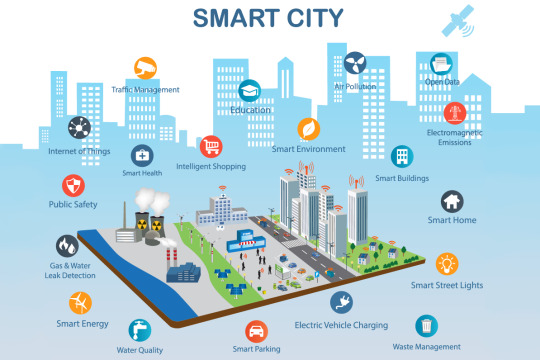
IoT Empowerment: IoT forms the bedrock of smart cities, and SAP's IoT solutions facilitate the seamless connection and management of countless devices and sensors. From smart traffic lights to waste bins, this connectivity allows real-time monitoring and control, enhancing everything from traffic management to environmental sustainability.
Predictive Analytics: SAP's predictive analytics tools enable cities to foresee trends and challenges. For instance, predictive maintenance identifies when critical infrastructure, like bridges or water pipes, may need attention before a major issue arises, saving both time and resources.
Citizen Engagement: Smart cities thrive on citizen involvement in decision-making. SAP provides platforms for citizen engagement, such as mobile apps and online portals, where residents can report issues, take part in surveys, and access information on city services and projects.
Energy Efficiency: Energy management is a top priority for smart cities, and SAP's smart solutions for smart cities help cities monitor and optimize energy consumption in public buildings, street lighting, and other municipal facilities. This smart solutions for smart cities reduces costs and environmental impact.
Conclusion
SAP's essential role in smart city development is assisting cities throughout the world in addressing the complex issues of rising urbanization and resource management. Cities are becoming more efficient, sustainable, and responsive to their inhabitants' demands by leveraging SAP's expertise in data management, IoT, and analytics. The influence of SAP smart business on the future of smart cities is poised to grow as technology progresses, providing more livable, connected, and resilient urban settings for future generations.
3 notes
·
View notes
Text
Cloud-based ERP and Business- Right Time to Migrate is Now
Table of Contents
Importance of Moving On-premise SAP B1 to the Cloud
Key Factors to Consider When Migrating to SAP Business One Cloud
Step-by-Step Guide to Migrating Your Existing SAP B1 to the Cloud
Concluding Thoughts
Many businesses rely on SAP Business One (SAP B1) to streamline operations and boost efficiency. However, small and medium-sized businesses (SMBs) with diverse models need more advanced solutions to thrive in today’s dynamic environment. Cloud technology, specifically the Best SAP Business One Cloud solution, can meet these needs, offering many benefits and a competitive edge.
In this post, we will explore the importance of cloud-based SAP Business One and the critical factors to consider when migrating your existing SAP B1 system to this powerful platform. Let's first look at the concept of a cloud-based ERP.
Importance of Moving On-premise SAP B1 to the Cloud
A cloud-powered ERP solution differs significantly from an on-premise system because it does not require installing hardware or software. As a managed cloud solution, this ERP offers seamless access from anywhere at any time via the Internet. SAP Business One Cloud is a prime example of such a solution.
In today’s digital era, where innovation drives success, migrating to the cloud is a strategic move for businesses. Moving your on-premise SAP B1 to the cloud brings benefits such as increased scalability, agility, and flexibility—all at a lower cost.
SMBs and startups prefer cloud-based solutions to save costs and enhance productivity. However, it’s crucial to consider several factors before migrating to SAP Business One Cloud to maximize its advantages. Let's explore these considerations before we dive into a step-by-step migration guide.
Key Factors to Consider When Migrating to SAP Business One Cloud
SAP Business One Cloud offers numerous benefits to forward-thinking businesses. However, migrating your existing SAP B1 system to the cloud is a complex process that involves several key aspects. Here are the essential factors to consider:
Cost of Ownership This is a crucial consideration whether you’re deploying SAP B1 on the cloud for the first time or migrating from an on-premise solution. A cloud-based SAP Business One system involves a monthly subscription fee for accessing licenses. However, this cost is considerably lower than maintaining an on-premise system, which requires expensive infrastructure and ongoing maintenance.
Implementation Time On-premise SAP Business One implementation can take between 3 to 6 months, a process that many small and mid-sized businesses find burdensome and time-consuming. Migrating to the cloud, however, is a quicker and more efficient process. A reliable managed cloud services provider can ensure minimal disruption during the migration.
Collaboration and Accessibility In the post-pandemic world, remote or hybrid work is the new norm. Therefore, ensuring that your cloud-based ERP is easily accessible to remote employees is essential. The solution should allow access from any location via the internet and should facilitate seamless collaboration between teams, regardless of their location.
Reliability of Provider Many cloud service providers offer migration services, but it’s important to choose a reliable and reputable provider. Understanding the provider’s maintenance, upgrade policies, and technical support services is essential to ensure minimal disruption during migration and ongoing support afterward.
Step-by-Step Guide to Migrating Your Existing SAP B1 to the Cloud
SAP Business One Cloud is an ideal solution for many SMBs. Regardless of the size or sector, businesses can benefit from the advantages of a cloud-based ERP solution by migrating from an on-premise system. Here’s a step-by-step guide to migrating your SAP Business One solution to the cloud effectively:
Step 1: Assess Existing Environment Before starting the migration, assess your current setup and business needs. It’s important to evaluate dependencies, customizations, and integrations with the help of a cloud service provider. This will help identify potential challenges and ensure a smooth transition from on-premise to the cloud.
Step 2: Choose the Right Plan Cloud service providers typically offer various packages to suit different business needs. Choose a plan that aligns with your company’s size, goals, and performance requirements. Consider aspects such as data storage capacity, scalability, and processing power when selecting the best package.
Step 3: Backup and Data Storage During the migration process, safeguarding corporate data is vital. Create a comprehensive backup of your on-premise SAP B1 data to prevent data loss or damage. Using advanced migration tools ensures a smooth data transfer with minimal downtime and maintains data integrity.
Step 4: Application and Database Migration The next step is migrating your SAP Business One application and databases to the cloud. Your cloud service provider’s technical team will assist in the secure and efficient migration process. Test the SAP B1 application in the new cloud environment to confirm that everything is functioning correctly.
Step 5: Integration and Performance Testing It’s important to thoroughly test integrations with other business applications to ensure seamless connectivity in the cloud environment. Extensive testing helps identify and resolve any compatibility issues, ensuring uninterrupted workflows and data synchronization.
Step 6: User Training and Adoption Prepare your team for the transition by providing comprehensive training on the new cloud-based SAP Business One system. Ensure that users are familiar with the upgraded features, accessibility, and collaborative tools offered by the managed cloud solution.
Step 7: Go Live and Monitoring Work with your cloud provider’s support team to finalize the migration and officially go live. Implement monitoring tools to track system performance, identify potential issues, and maintain optimal functioning of the SAP B1 application in the cloud.
Following these steps ensures a successful migration, allowing your business to leverage the full potential of a cloud-based SAP B1 solution.
Concluding Thoughts
Migrating your existing SAP Business One on-premise solution to the cloud can be complex, but this step-by-step guide, along with key considerations, will help you navigate the process smoothly. The most important aspect is selecting the right cloud partner for a seamless transition with minimal downtime and maximum data safety.
B1 Partner Cloud is your trusted SAP solutions provider, offering 360-degree services, from implementation to maintenance, upgrades, and cloud migration as an official SAP Partner. Contact us to learn more about our SAP Business One and managed cloud solutions for modern businesses.
Source - https://www.b1partner.cloud/cloud-based-erp-and-business-right-time-to-migrate-is-now/

2 notes
·
View notes
Text
Unlock Business Insights with SAP Predictive Analytics for Growth

In the fast-evolving landscape of business technology, finance transformation is at the forefront of discussions. With companies increasingly looking for solutions that improve decision-making, streamline processes, and ensure regulatory compliance, SAP solutions are becoming essential. CBS Consulting is proud to support businesses in Malaysia with cutting-edge technologies such as SAP Predictive Analytics, SAP Low Code No Code (LCNC) platforms, and comprehensive e-invoicing Malaysia solutions that ensure full compliance with Malaysia E-Invoicing Compliance regulations.
Unlock the Power of SAP Predictive Analytics
SAP Predictive Analytics is a game-changer for businesses looking to harness the power of data for better decision-making. By leveraging machine learning and advanced data models, SAP Predictive Analytics helps companies anticipate market trends, optimize operations, and reduce risks. Whether in finance, operations, or customer management, the insights derived from predictive analytics can drive efficiency and profitability. CBS Consulting's expertise in implementing SAP Predictive Analytics allows businesses in Malaysia to stay ahead of the curve by turning data into actionable insights.
Accelerating Finance Transformation with SAP
The finance transformation journey is complex but crucial for businesses seeking agility, accuracy, and scalability. Finance Transformation SAP solutions provide robust systems that empower finance departments to automate processes, enhance reporting accuracy, and improve financial forecasting. CBS Consulting helps organizations seamlessly integrate SAP finance transformation solutions, ensuring a smooth transition with minimal disruption. By leveraging SAP's cloud-based and on-premise financial systems, businesses can manage their resources more effectively, reduce manual errors, and drive strategic growth.
SAP Low Code No Code (LCNC) Revolution
SAP Low Code No Code (LCNC) platforms are revolutionizing how businesses build and deploy applications. With minimal coding expertise required, these platforms enable companies to develop custom applications quickly, making innovation more accessible. Businesses can automate workflows, streamline data management, and accelerate digital transformation without the need for complex coding. CBS Consulting leverages SAP LCNC platforms to help businesses in Malaysia create tailor-made solutions that address their unique challenges, empowering them to innovate faster and improve operational efficiency.
E-Invoicing in Malaysia: Compliance and Efficiency
Malaysia's mandatory e-invoicing Malaysia regulation is reshaping how businesses handle invoicing. Starting in 2025, all companies must comply with the Malaysia E-Invoicing Compliance requirements, a significant shift towards digital transformation. E invoicing Malaysia streamlines the invoicing process, reduces errors, and enhances transparency. CBS Consulting provides expert guidance on integrating SAP e-invoicing Malaysia solutions to ensure that businesses in Malaysia meet compliance standards effortlessly. Our solutions help companies adopt e-invoicing Malaysia quickly, minimizing risks of non-compliance and ensuring smoother audits and reporting.
Why Choose CBS Consulting?
At CBS Consulting, we understand the unique challenges faced by businesses in Malaysia. Our team of SAP-certified professionals ensures the successful implementation of SAP Predictive Analytics, Finance Transformation SAP solutions, SAP Low Code No Code (LCNC) platforms, and SAP e-invoicing systems, all while ensuring compliance with Malaysia E-Invoicing Compliance regulations. We are committed to helping businesses enhance their operational efficiency and stay compliant with the latest technological advancements.
If you're ready to embrace the future of finance transformation SAP, predictive analytics, and e-invoicing compliance, CBS Consulting is here to guide you through the journey. Contact us today to learn how we can help your business thrive in the digital age.
1 note
·
View note
Text
Overcoming Common Challenges in ERP Implementation for Manufacturing
In the dynamic and constantly changing environment of the industrial sector, enterprises must maintain flexibility and strive for competitiveness. Enterprise Resource Planning (ERP) software is a pivotal instrument that facilitates manufacturers in attaining their objectives. Enterprise Resource Planning (ERP) systems provide a broad range of integrated applications that are specifically developed to optimise operational processes, enhance productivity, and facilitate organisational expansion. Nevertheless, despite their considerable potential, ERP for manufacturing industry projects frequently encounter typical obstacles that can impede their achievement.
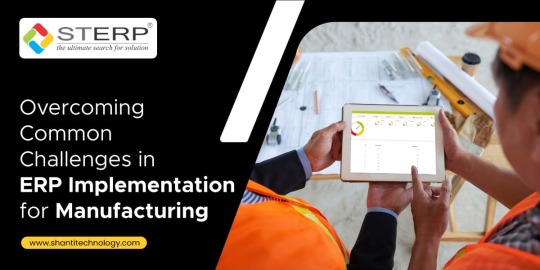
This blog post aims to examine the world of ERP for manufacturing industry, focusing on the most effective ERP solutions suitable for manufacturing enterprises of varying scales, encompassing both large-scale operations and small-scale organisations. Furthermore, we will explore the common challenges that manufacturers face during the adoption of the best ERP software for manufacturing companies and offer practical strategies for overcoming these difficulties.
The Power of ERP for Manufacturing:
Prior to delving into the complexities and remedies associated with the adoption of Enterprise Resource Planning (ERP), it is essential to comprehend the profound impact that ERP systems have on the manufacturing sector.
· ERP for Manufacturing Industry:
The manufacturing industry is characterised by intricate procedures, a wide range of product offerings, and complicated supply chain dynamics. Enterprise Resource Planning (ERP) demonstrates its exceptional capabilities in this context. Enterprise Resource Planning (ERP) systems for manufacturing encompass the integration of several operational tasks, such as production planning, inventory management, quality control, and finance management, under a unified and interconnected platform. The integration described herein provides manufacturers with the capability to access real-time visibility into their operations, hence facilitating data-driven decision-making and improving overall efficiency.
· Best ERP for Manufacturing Industry:
When it comes to the selection of ERP software for the manufacturing industry, it is imperative to carefully evaluate a system that is in line with the unique requirements of the organisation. Prominent enterprise resource planning (ERP) solutions catering to the manufacturing industry encompass SAP S/4HANA, Oracle ERP Cloud, Microsoft Dynamics 365, and STERP by Shanti Technology. These solutions provide comprehensive functionalities specifically designed for manufacturing processes, enabling organisations to enhance production efficiency, minimise expenses, and enhance overall profitability.
· ERP for Small Manufacturing Businesses:
Enterprise Resource Planning (ERP) systems are not exclusively designed for huge organisations but can also be beneficial for small manufacturing businesses. ERP systems can provide significant advantages to small manufacturing enterprises as well. Indeed, the implementation of an appropriate Enterprise Resource Planning (ERP) solution can effectively equalise the competitive landscape for small-scale firms, equipping them with the necessary resources to compete efficiently. Scalable choices, such as Shanti Technology's STERP, present themselves as suitable solutions for small enterprises seeking expansion opportunities.
Challenges in ERP Implementation for Manufacturing:
Although the potential benefits of Enterprise Resource Planning (ERP) are alluring, the process of deploying such systems might be perceived as a formidable endeavour accompanied by several obstacles. Manufacturers frequently encounter several challenges in their operations.
· Resistance to Change:
Resistance to change is a prominent obstacle encountered with the adoption of Enterprise Resource Planning (ERP) systems. There may exist a certain degree of resistance among employees who have become accustomed to utilising legacy systems over an extended period of time, hence exhibiting hesitancy towards embracing novel technological advancements. In order to surmount this problem, it is imperative to engage employees from the inception, effectively communicate the advantages of Enterprise Resource Planning (ERP), and offer thorough training and assistance.
· Data Migration:
The process of data migration is often characterised by its complexity and time-intensive nature. The process of migrating data from outdated legacy systems to a modern Enterprise Resource Planning (ERP) system has the potential to result in errors and compromise the integrity of the transferred data. The rigorous planning, validation of data accuracy, and implementation of a comprehensive data migration strategy are crucial.
· Integration Issues:
The effectiveness of ERP systems relies on their ability to smoothly integrate with other software and systems utilised inside the organisation. The integration process may encounter difficulties when preexisting systems lack compatibility with the newly implemented Enterprise Resource Planning (ERP) system. Conducting a comprehensive compatibility study and making necessary investments in middleware are critical measures to ensure seamless integration.
· Budget Overruns:
Budget overruns are a common occurrence in Enterprise Resource Planning (ERP) implementations, mostly attributed to unanticipated expenditures such as customisation, supplementary training, or prolonged project schedules. In order to address the issue of budget overruns, it is advisable to develop a comprehensive budget plan, including provisions for unforeseen circumstances, and maintain vigilant oversight of expenditures during the execution phase.
Overcoming ERP Implementation Challenges:
· Change Management:
In order to mitigate resistance towards change, it is imperative to involve employees at an early stage of the process. Organise seminars, facilitate training sessions and effectively articulate the advantages of the Enterprise Resource Planning (ERP) system. Promote the solicitation of feedback and implement necessary modifications in accordance with user input. Resistance to the implementation of the best ERP software for manufacturing company tends to decrease when employees perceive the system's usefulness and receive enough support during the transition process.
· Data Migration Strategy:
The effectiveness of data migration is contingent upon thorough planning and precise implementation. Establish a data migration team tasked with the responsibilities of data cleansing, validation, and mapping. It is advisable to conduct testing of data migration procedures inside a controlled setting prior to executing the implementation on a larger scale. It is imperative to consistently perform data backups in order to safeguard data integrity throughout the transfer process.
· Integration Expertise:
In order to address integration difficulties, it is advisable to engage in collaboration with ERP suppliers and IT professionals who possess specialised knowledge and skills in the field of integration. These individuals possess the ability to identify possible challenges related to integration and devise appropriate strategies to address them. It is advisable to explore the option of investing in middleware or connectors that can effectively facilitate the integration process between the Enterprise Resource Planning (ERP) system and the pre-existing systems.
· Budget Management:
In order to mitigate the occurrence of budget overruns, it is advisable to design a budget that is grounded in realism and includes a contingency fund. It is advisable to conduct periodic evaluations of expenditures and make necessary modifications to the budget accordingly. It is advisable to give precedence to fundamental customization and supplementary components while postponing non-essential functionalities to subsequent stages of the implementation process. The implementation of a staged approach can effectively manage expenses while also guaranteeing the establishment of essential functionality.
Leveraging STERP for Manufacturing Company:
In the context of addressing the obstacles encountered during ERP adoption, it is vital to underscore the potential value that Shanti Technology's STERP solution holds for manufacturers.
· STERP's Manufacturing Expertise:
The manufacturing expertise of STERP is highly regarded as it is an ERP solution that has been specifically tailored to meet the needs of the manufacturing industry. The software provides a variety of functionalities specifically designed for manufacturing operations, including but not limited to demand prediction, production scheduling, and quality management. The industry-specific experience of STERP facilitates the deployment process and guarantees a seamless alignment between your ERP system and your manufacturing requirements.
· Scalability for Small Manufacturers:
Scalability is a crucial aspect for small manufacturers, and it has been observed that the Small Manufacturer Enterprise Resource Planning (STERP) system offers a viable solution in this regard. As an enterprise expands, the Scalable Technology and Enterprise Resource Planning (STERP) system may effectively meet the increasing requirements, so serving as a favourable option for organisations seeking efficient scalability without the necessity of investing in a new Enterprise Resource Planning (ERP) system in the future.
· Comprehensive Training and Support:
STERP provides a comprehensive training and support programme aimed at facilitating a seamless changeover process. STERP offers a comprehensive range of services, including on-site training sessions and round-the-clock customer support, to ensure that your staff is adequately equipped to maximise the efficiency and effectiveness of the ERP system.
Final Thoughts:
The deployment of Enterprise Resource Planning (ERP) systems in the manufacturing business presents several difficulties. However, by employing appropriate techniques and utilising the best ERP software for manufacturing companies, developed by STERP (Shanti Technology), these issues can be effectively addressed. Manufacturers can optimise the utilisation of ERP systems by effectively handling resistance to change, methodically preparing data migration, managing integration processes efficiently, and maintaining strict adherence to budgetary considerations.
It is important to acknowledge that the adoption of Enterprise Resource Planning (ERP) systems should not be viewed as a singular occurrence, but rather as a continuous endeavour aimed at achieving optimal performance. It is imperative to consistently evaluate the performance of your Enterprise Resource Planning (ERP) system, solicit input from users, and remain abreast of prevailing industry standards in order to ascertain that your ERP system is capable of efficiently supporting your manufacturing activities.
The STERP system represents an optimal enterprise resource planning (ERP) solution specifically designed for the manufacturing sector. It provides customised functionalities, scalability, and comprehensive assistance to enable firms to excel in a highly competitive market. Manufacturers can achieve operational streamlining, enhanced efficiency, and long-term success in the ever-changing industrial landscape by making informed decisions on the selection of an appropriate Enterprise Resource Planning (ERP) solution according to established implementation best practices.
#ERP for manufacturing industry#Best ERP for manufacturing industry#ERP for small manufacturing business#Best ERP software for manufacturing#Manufacturing software for small business#Best ERP for small manufacturing business#ERP software for manufacturing industry#ERP for manufacturing company
7 notes
·
View notes